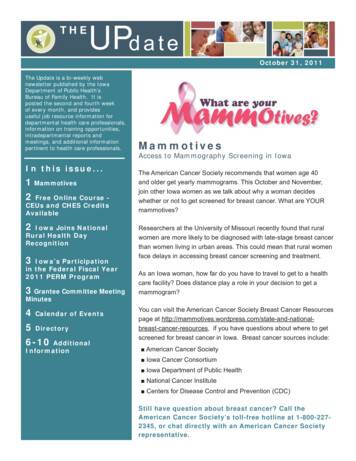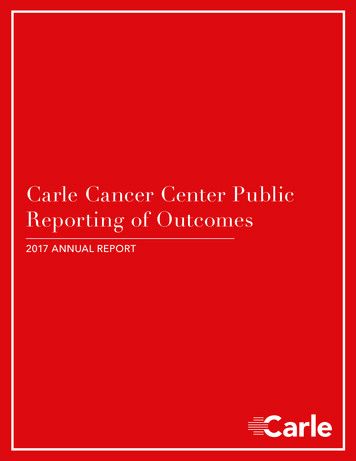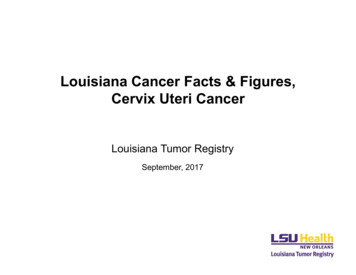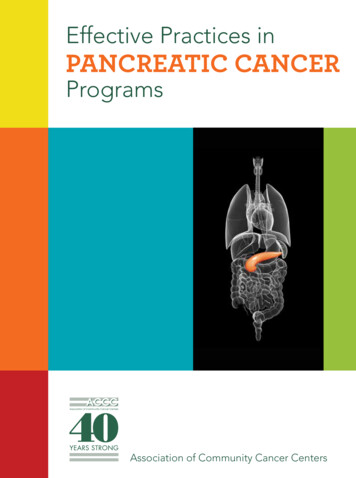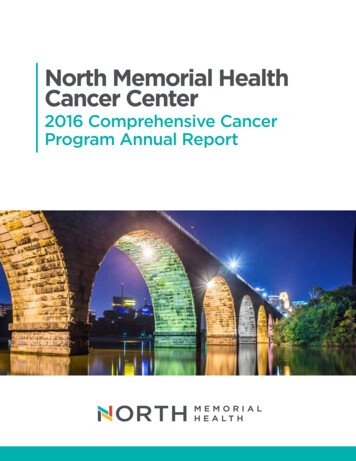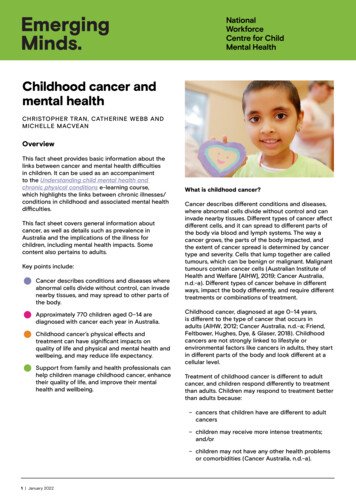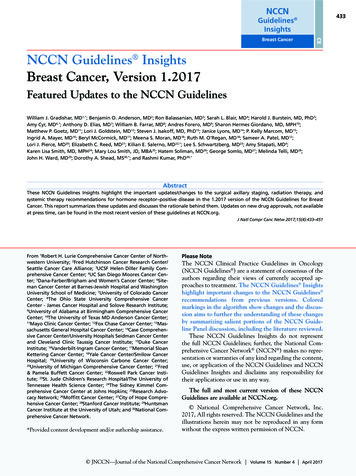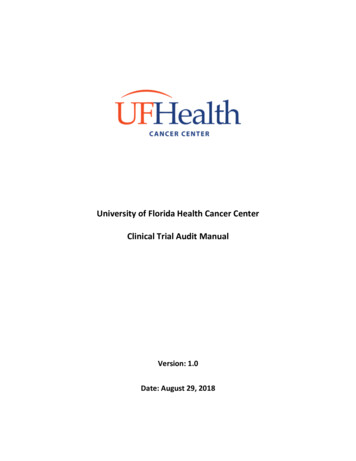
Transcription
University of Florida Health Cancer CenterClinical Trial Audit ManualVersion: 1.0Date: August 29, 2018
UFHCC Clinical Trial Audit ManualTABLE OF CONTENTSABBREVIATIONS . 4DEFINITIONS. 5I.INTRODUCTION/BACKGROUND . 6II.SCOPE . 6III.CLINICAL TRIALS AUDITING TEAM . 6IV.UFHCC COMPLIANCE GROUP . 7Meeting Structure & Responsibilities . 7Membership . 8V.GENERAL AUDIT OPERATIONS . 8VI.PROTOCOL SELECTION . 9VII.SUBJECT SELECTION . 9VIII.AUDIT SCHEDULING . 10IX.PREPARING FOR AN AUDIT . 10The Clinical Trials Auditing Team Auditor . 10The Principal Investigator and Study Team . 11During the Audit Visit . 11X.AUDIT TYPES AND ASSOCIATED PROCEDURES . 12Full Audits . 12Process Audits . 13Mock Audits . 13Re-Audits . 13XI.AUDIT FINDINGS . 13XII.CRITICAL, MAJOR, AND LESSER DEFICIENCIES . 14XIII.EXIT INTERVIEW . 15XIV.AUDIT RESPONSE REVIEW AND SUBMISSION . 15XV.CORRECTIVE AND PREVENTITIVE ACTION PLAN . 15XVI.MAINTENANCE OF AUDIT INFORMATION . 16Audit repository . 16Audit logs . 16XVII.REFERENCES . 16XVIII.APPENDICES . 17Appendix A. Study Documentation Audit Checklist . 17Appendix B. Subject Audit Checklist . 22Version 108/20/2018Page 2 of 35
UFHCC Clinical Trial Audit ManualAppendix C. Audit Deficiencies Reference Chart . 26Appendix D. Summary of Audit Findings (Example) . 32Appendix E. Corrective and Preventative Action Plan Template . 34Appendix F. Audit and Monitoring Log . 35Version 108/20/2018Page 3 of 35
UFHCC Clinical Trial Audit ManualABBREVIATIONSAD-CROAdministrative Director of the Clinical Research OfficeADCIAssociate Director for Clinical InvestigationAEAdverse eventARCAffiliate Research ConsortiumCAPACorrective and preventative actionCROClinical Research OfficeCTATClinical Trials Auditing TeamCTMBClinical Trials Monitoring BranchDISCData Integrity and Safety CommitteeDOADelegation of authorityDSGDisease Site GroupDSMPData and Safety Monitoring PlanETCTNExperimental Therapeutics Clinical Trials NetworkFDAFood and Drug AdministrationGCPGood Clinical PracticeICHInternational Council for HarmonizationIITInvestigator initiated trialIRBInstitutional review boardNCINational Cancer InstituteNCI CIRBNational Cancer Institute Central Institutional Review BoardNCTNNational Clinical Trials NetworkPIPrincipal investigatorSAESerious adverse eventUFHCCUniversity of Florida Health Cancer CenterVersion 108/20/2018Page 4 of 35
UFHCC Clinical Trial Audit ManualDEFINITIONSActive Study: Any research study that is being conducted under an active approval by an institutional review board(IRB). These studies are typically in an open to accrual or follow-up status in OnCore. Studies move into an inactivestatus once they have been formally closed with the IRB.Auditing: A “systematic and independent examination of trial-related activities and documents to determinewhether the evaluated trial-related activities were conducted, and the data were recorded, analyzed, andaccurately reported according to the protocol, sponsor’s standard operating procedures, good clinical practice(GCP), and the applicable regulatory requirement(s)” International Council for Harmonization (ICH) E6 1.6.Clinical Trial: The National Institutes of Health defines a clinical trials as “a research study in which one or morehuman subjects are prospectively assigned to one or more interventions (which may include placebo or othercontrol) to evaluate the effects of those interventions on health-related biomedical or behavioral outcomes.”Critical Deficiency: As written in the Clinical Trial Monitoring Branch (CTMB) of the National Cancer Institute (NCI)Guidelines, a critical deficiency is “any condition, practice, process or pattern that adversely affect the rights, safetyor wellbeing of the patient/study participant and/or the quality and integrity of the data; includes serious violationof safeguards in place to ensure safety of a patient/study participant and/or manipulation and intentionalmisrepresentation of data.”Intervention: The National Institutes of Health defines an intervention as “a manipulation of the subject orsubject’s environment for the purpose of modifying one or more health-related biomedical or behavioralprocesses and/or endpoints.” Examples include: drugs/small molecules/compounds; biologics; devices; procedures(e.g., surgical techniques); delivery systems (e.g., telemedicine, face-to-face interviews); strategies to changehealth-related behavior (e.g., diet, cognitive therapy, exercise, development of new habits); treatment strategies;prevention strategies; and, diagnostic strategies.”Investigator Initiated Trial: Any clinical trial that was initiated and conducted by a sponsor-investigator. The FederalDrug Administration (FDA) defines a sponsor-investigator as “an individual who both initiates and conducts aninvestigation, and under whose immediate direction the investigational drug is administered or dispensed.” TheUniversity of Florida (UF)’s investigator initiated trials (IITs) are further characterized as trials that bothoriginated at UF and are centrally managed by the institution.Lesser Deficiency: As written in the CTMB NCI Guidelines, a lesser deficiency is a finding that “does not havesignificant impact on the outcome or interpretation of the study and is not described above as a major deficiency.”An unacceptable frequency/quantity of lesser deficiencies should be treated as a major deficiency whendetermining the final assessment of a component.”Major Deficiency: As written in the CTMB NCI Guidelines, a major deficiency is “a variance from protocol-specifiedprocedures or practices that makes the resulting data questionable.”Principal Investigator: An individual who actually conducts a clinical investigation (i.e., under whose immediatedirection the study intervention is carried out on a participant). In the event an investigation is conducted by ateam of individuals, the principal investigator (PI) has the ultimate responsibility for the conduct of the researchproject.Sub-Investigator: Any other member of the research team who will make clinical decisions during the research ormake a direct and significant contribution to the data. The ICH Good Clinical Practices (GCP) Guideline defines asub-investigator as “any individual member of the clinical trial team designated and supervised by the investigatorat a trial site to perform critical trial-related procedures and/or to make important trial-related decisions.”Version 108/20/2018Page 5 of 35
UFHCC Clinical Trial Audit ManualI.INTRODUCTION/BACKGROUNDAuditing is a function that is distinct from routine monitoring and quality control processes. The primarypurpose of an audit is to evaluate overall study conduct and compliance with the protocol, the sponsor’sstandard operating procedures, the GCP Guidelines, and regulatory requirements at a very high level.This is not interchangeable with monitoring, which is a continuous function, though there is overlap withthe study content that is reviewed.The Clinical Trials Auditing Team (CTAT), which comprises of staff from the UF Health Cancer Center(UFHCC) Clinical Research Office (CRO), is responsible for conducting internal audits of applicable clinicaltrials. Trials are selected for audit per the guidelines outlined by this audit manual and the UFHCC Dataand Safety Monitoring Plan (DSMP). The CTAT conducts quality assurance audits of all clinical trialsconducted by the UFHCC, UF IITs, and National Clinical Trials Network (NCTN) studies conducted byUFHCC Affiliate Research Consortium (ARC) sites. The CTAT follows guidelines based upon thoseestablished by the CTMB of the NCI. During audits, a CTAT member, or members, will comparesubmitted data with corresponding source documentation and assess protocol and regulatorycompliance, informed consent accuracy and documentation, eligibility, treatment administration,response evaluation, adverse events (AEs), overall data quality, IRB documentation, and pharmacyrecords.II.SCOPEThis manual applies to all active clinical trials conducted at UFHCC, regardless of sponsorship. Thismanual also applies to UF IITs and NCTN studies conducted at ARC sites. The NCI defines a clinical trial as“a prospective study involving human subjects designed to answer specific questions about the effectsor impact of a particular biomedical or behavioral interventions; these may include drugs, treatments,devices, or behavioral or nutritional strategies.” Trial participants may include current or former cancerpatients, persons without cancer who may be at risk for developing cancer, or healthy volunteercontrols enrolled in cancer-relevant studies.UF defines a cancer-relevant study as one that meets at least one of the following criteria: III.Specifies enrolling patients with a known or suspected diagnosis of cancer as part of theeligibility criteria;Includes research endpoints related to cancer, associated symptoms, or established cancer riskfactors (including smoking and tobacco-associated studies, surveys, hepatitis or humanpapilloma virus vaccines, etc.); orThe local PI plans to exclusively enroll current, former, or potential cancer patients into thestudyCLINICAL TRIALS AUDITING TEAMThe CTAT provides ongoing auditing for complex through low-risk clinical trials. Audits are conductedper the outlined review frequency in the UFHCC DSMP. Routine, random, and “for cause” audits may beconducted for any cancer-relevant externally sponsored studies. All auditing activities are performed inaccordance with the ICH GCP Guidelines. The CTAT audit process is also intended to evaluate theVersion 108/20/2018Page 6 of 35
UFHCC Clinical Trial Audit Manualeffectiveness of current training, education, and monitoring practices. Findings may translate tomodifications in standard operating procedures, policies, or research oversight system activities.UFHCC DirectorNCI ReportingDeputy DirectorUFHCCAssociate Director for ClinicalInvestigationData and Safety MonitoringData Integrity andSafetyCommittee (DISC)Compliance and Quality AssuranceClinical Research OfficeLeadershipUFHCCComplianceGroupClinicalTrials AuditTeamThe CTAT has fullauthority to accessresearch and pertinentclinical records of allpatients enrolled instudies that fall under itsreview. This is done in theinterest of current andfuture subjects as well asnon-study patients thatmay be impacted by theresults of our trials.CROEducation &TrainingTeamFormal reportssummarizing the findingsof audits withInternal &Externalidentification of anyMonitoringspecific findingsInstitutionalwarranting creation of aReview BoardStudy Teamcorrective andSub-Is, CRCs, CRAs, RegulatoryStaff, etc.preventative action(CAPA) plan are providedto the PI and study teamfor review and response. CTAT audit reports are also provided to the Associate Director for ClinicalInvestigation (ADCI) and the Administrative Director of the CRO (AD-CRO).Scientific Review andMonitoring CommitteeIV.UF PrincipalInvestigatorExternalAuditingUFHCC COMPLIANCE GROUPThe UFHCC Compliance Group was formed to systematically evaluate the UFHCC internal audit findingsand to identify any potential clinical or operational barriers to research compliance.Meeting Structure & ResponsibilitiesThe Compliance Group meets monthly to ensure timely oversight of internal and external audits. Thegroup reviews all internal audit reports provided by the CTAT and discusses the protocol audit findings.The group makes recommendations regarding when additional corrective action(s) and/or additionaleducation is needed to ensure improvements in quality and research compliance.The group provides a monthly summary to the Data Integrity and Safety Committee (DISC) of the auditsreviewed and any issues that were identified at the last meeting. In addition, the Compliance Group canrefer any major problems that have been identified to the DISC for consideration and possibleimmediate action.At each convened DISC meeting, the DISC reviews the audit summaries and findings and determines ifadditional corrective action is necessary.Version 108/20/2018Page 7 of 35
UFHCC Clinical Trial Audit ManualMembershipMembership includes representation from UFHCC leadership and CRO staff including: The ADCIThe AD-CRODivision of Quantitative SciencesProject Management and Regulatory AffairsClinical Research Administration and ComplianceStudy Coordination and Data ManagementA group roster is stored within the UFHCC Administrative Office.V.GENERAL AUDIT OPERATIONSThe audit process begins with the selection of a protocol. The CTAT selects protocols according to setcriteria, such as DISC assignment, risk level as assigned by the Scientific Review and MonitoringCommittee (if applicable), disease site group (DSG), time since last audit, requests for audit, newinvestigators and/or study coordinators, and number of subjects accrued. Once the protocols have beenchosen, the trial is assigned to a CTAT auditor. Assignments are based on the auditor’s current caseloadand individual knowledge base of the assigned protocol and/or disease site.The CTAT auditor contacts the PI and study team via email with information to review in preparation forthe audit approximately 2 weeks in advance of the audit. The email contains the audit notification,which describes the audit proceedings, how to prepare for the audit, and a list of randomly selectedsubjects to be audited. During the audit, the CTAT auditor compares the medical records and researchfiles to the protocol and submitted forms to verify compliance with protocol and regulatoryrequirements as well as the accuracy of data collection.It is important for the PI and study team to be available during the audit to assist the CTAT auditor asneeded. The CTAT auditor completes an audit review form for each subject reviewed to assess datacollection and protocol compliance as documented in the record. Following the audit, the CTAT auditorwill conduct an exit interview with the PI and study team. During the exit interview, the PI and studyteam will have an opportunity to verbally discuss the preliminary findings, recommendations, orquestions that have arisen during the audit. In situations where missing data has been identified, the PIand study team will be given 2 business days to produce the requested documentation.The PI and study team will be sent a final letter of audit findings via email within 5 business daysfollowing the exit interview. The PI will be asked to acknowledge receipt of the audit report and replywith a CAPA plan, if applicable, via email. The Compliance Group will then assess the PI’s response todetermine if further action is necessary. The group communicates this information to the DISCAdministrator approximately 2 weeks prior to the DISC review meeting. DISC is responsible forcommunicating any additional recommendations or requirements to the PI and study team followingcommittee review of the findings.An affiliate (ARC member) site may be audited separately or in conjunction with the main institution. Ifan affiliate site is to be audited separate from the main institution, they will be notified separately of themain institution and a separate audit report will be generated for each affiliate site that is audited.Version 108/20/2018Page 8 of 35
UFHCC Clinical Trial Audit ManualTimelines listed here are ideal; however, there may be some variations in practice due to limitations inscheduling/availability.VI.PROTOCOL SELECTIONThe lead CTAT auditor is responsible for selecting and scheduling audits for the CTAT. Audits of clinicaltrials subject to the UFHCC’s research oversight system will be scheduled according to the guidelinesoutlined in the UFHCC DSMP.Protocol PrioritizationAudit FrequencyUF IIT or DISC monitoringrequiredFollows the monitoring frequency chart found in the DISC Charter.UF IITs conducted at ARCsitesAt a minimum, the first subject enrolled on a UF IIT protocol at a UFHCCARC member site will be audited. This is in addition to the level ofmonitoring required per assigned monitoring plan for that specificprotocol.NCTN/ExperimentalTherapeutics ClinicalTrials Network (ETCTN)trialsAt a minimum, each NCTN/ETCTN study will be audited annually. At least10% or a minimum of 2 cases will be selected from each study.Externally sponsoredstudiesAt a minimum, 2 externally sponsored studies from each DSG (notincluding NCTN or ETCTN trials) will be audited annually. At least one casewill be selected from each study.New PIsAt a minimum, one enrolled subject and up to 3 additional subjects will beaudited within the PI’s first year. These cases are separate from requiredDISC, NCTN/ETCTN, and/or DSG based auditing requirements.New coordinatorsAt a minimum, one enrolled subject and up to 3 additional subjects will beaudited within the coordinator’s first year. These cases are separate fromrequired DISC-, NCTN/ETCTN-, and/or DSG-based auditing requirements.For causeVII.As needed.SUBJECT SELECTIONSubject selection for routine audits will be completed using a randomizing program and will represent aminimum number of enrolled study subjects for the selected protocol as outlined in the UFHCC DSMP.The number of subjects selected may vary depending on the protocol prioritization chart in Section VI.PROTOCOL SELECTION). Subject selection is random, impartial, and will take into accountsubjects accrued during the specified audit review period. In order to maintain the highest qualityprotocol-specific research data, subject charts will be audited thoroughly for informed consentdocumentation, original source documentation required to support protocol compliance, and otherrelevant information. Usually, only cases entered since the last audit will be selected, but any accruedVersion 108/20/2018Page 9 of 35
UFHCC Clinical Trial Audit Manualcases (even those that were previously audited) might be selected. In situations where a previouslyaudited case is selected, only activities occurring after the prior audit will be reviewed.VIII.AUDIT SCHEDULINGA scheduled audit date will be set for a time that is mutually convenient for both the auditors and thesite. The type of audit will be specified as either full, process, mock, routine, or “for cause.” The assignedCTAT auditor will notify the study PI and primary study coordinator of pending routine auditsapproximately 2 weeks in advance. Advance notification for a “for cause” audit is not required. The leadand affiliate sites for multi-institution trials may be notified together or separately. The auditor willcommunicate the audit process via email and will include the following: A full inventory of items to be audited including all announced subject casesLogistics, including the date, time, and location of the auditA request for exit interview schedulingA link to this UFHCC Audit Manual and the UFHCC DSMP for review of the research oversightsystem and audit process, as applicableThe PI and/or primary study coordinator should make every effort to be available for questions on thedate(s) selected.IX.PREPARING FOR AN AUDITPrior to the audit, the PI and study team are responsible for gathering and organizing all records inpreparation for the audit. It is expected that the auditor will have access to all required documents andthe information be organized in such a way as to be easily located and identified. The PI and study teammust plan to have records available to the CTAT auditor(s) at the designated audit location. If the CTATauditor is expected to audit electronic documents, it is the responsibility of the PI and study team toensure that the CTAT auditor is granted access throughout the audit process.The Clinical Trials Auditing Team AuditorPrior to the audit, the CTAT auditor is responsible for the following:1. Review of accrual information in OnCore, which includes new subjects enrolled since the lastvisit, previously audited subjects, and completed (fully reviewed) subjects.2. Review of the protocol regulatory files to verify/request availability of:a. IRB initial approvalb. IRB approval of amendmentsc. IRB approval of annual continuing reviewsd. A current and approved version of the protocol and informed consent documente. Reported AEsf. IRB written approval of the protocol from any affiliate institution involved in the audit3. Review of prior audit records and findings4. Two business days before the audit, the CTAT Auditor will email or call a member of the studyteam to confirm the date and place of the final audit and to indicate whether anydocumentation is missing. This will give the study team an opportunity to find thisdocumentation for the audit visit.Version 108/20/2018Page 10 of 35
UFHCC Clinical Trial Audit ManualThe Principal Investigator and Study TeamPrior to the audit, the PI and study team are responsible for the following:1. Gathering all inpatient and ambulatory records for the selected subjects related to the conductof the trial2. Gathering completed case report forms and research files for the selected subjects3. Obtaining access to required electronic data capture systems that the CTAT auditor will need touse when verifying source documentation in advance of the CTAT auditor’s arrival (e.g., REDCapor other data reporting tools)4. Contacting the pharmacy to arrange access to Vestigo to review all records regarding thedispensing of investigational product, if applicable5. Compiling original eligibility checklists, consents, and off-study forms for the selected subjects6. Ensuring all source documentation is available to the auditor7. Creating documentation to address discrepancies that require clarification for the researchrecord8. Ensuring the regulatory binder is complete and up-to-date9. Uploading the following study-related and subject-related documentation in OnCore (asapplicable):a. All IRB records, such as all protocol and consent versions and their approval letters aswell as records of all revisionsb. All subject records that are related to the study, such as all signed consents, all studyrelated visits, procedures, results, AEs, serious AEs (SAEs), and deviations10. Communicating with other participating sites as the lead sit, which will have subjects selected11. Ensuring all requested cases are delivered to the designated audit area or the auditPLEASE REFER TO XVIII.APPENDICESAppendix A. Study Documentation Audit Checklist, Appendix B. Subject Audit Checklist, and Section X.AUDIT TYPES AND ASSOCIATED PROCEDURES) for items that will be audited.During the Audit VisitAt visit initiation, the CTAT auditor is responsible for signing in on the UFHCC Audit and Monitoring Log.The original document is to be filed under the appropriate tab of the regulatory binder. If the trial isindustry sponsored, the original document will be kept in the appropriate binder located in the UFHCCCRO. The PI and study team are responsible for providing access to the required medical records,research files, and other documentation. CTAT auditors are encouraged to contact the PI or study teammembers during the audit to attempt to resolve any questions that may arise. This will help to avoiderroneous violations from being cited and result in a more accurate assessment of protocol andregulatory compliance and data verification. The CTAT auditor will complete an audit review form forregulatory, pharmacy (if applicable), and each subject selected. At the exit interview, the CTAT auditoris responsible for obtaining the signature of a study team member on the UFHCC Audit and MonitoringLog.Version 108/20/2018Page 11 of 35
UFHCC Clinical Trial Audit ManualX.AUDIT TYPES AND ASSOCIATED PROCEDURESFull AuditsA full audit is a complete and comprehensive review of all protocol-specific activities. A full audit willusually include a review of the following, but can vary slightly:1. Regulatory (may include, but not limited to)a. Documentation of initial IRB approvalb. Documentation of annual renewalc. Documentation of IRB submission and approval for all amendments and revisionsd. Documentation of SAE/UP submission and acknowledgement/approval, if applicablee. Submission and acknowledgement/approval of safety reports, if applicablef. IRB submission or filing (as appropriate) of other study submissions including deviationsand other correspondenceg. Informed consent contenth. Completed delegation of authority (DOA) logsi. Completed training logsj. Investigational new drug or exemption documentation, as applicablek. IRB Membership listl. Essential Documents2. Subject Case (may include, but not limited to)a. Informed Consentb. Eligibilityc. Registrationd. Treatmente. Drug Accountability (if applicable)f. Disease Outcome/Responseg. Follow-Uph. AEs and SAEsi. Concomitant medicationsj. Toxicitiesk. Lab Tests/Study Proceduresl. Data Qualitym. Protocol deviations and/or violationsn. Other (at the CTAT auditor’s discretion)3. Pharmacy (may include, but not limited to)a. Drug inventory records, including orders, transfers, and returnsb. Temperature control logsc. Investigational agent expiration datesd. Pharmacy Manual, if applicable per studye. Training logsFormal reports summarizing the findings of audits with identification of any specific findings warrantinga CAPA plan are provided to the PI for review and response. A copy of the formal audit report will alsobe provided to the DISC Administrator, ADCI, and AD-CRO.Version 108/20/2018Page 12 of 35
UFHCC Clinical Trial Audit ManualProcess AuditsA process audit is a systematic review of the clinical trial process and is typically a less detailed reviewthan a full audit. Process audits are done on an as needed basis. Process audits are intended to identifyareas for improvement by evaluating trends in conduct and compliance. Process audits are also useful inidentifying successful processes and providing positive feedback to study teams. Upon completion of aprocess audit, results are reported to identify positive trends that should be reinforced and negativetrends to be addressed through training, policy revisions, and/or corrective and preventative actionplanning. The scope of a process audit will vary and
The Clinical Trials Auditing Team (CTAT), which comprises of staff from the UF Health Cancer Center (UFHCC) Clinical Research Office (CRO), is responsible for conducting internal audits of applicable clinical trials. Trials are selected for audit per the guidelines outlined by this audit manual and the UFHCC Data and Safety Monitoring Plan (DSMP).



